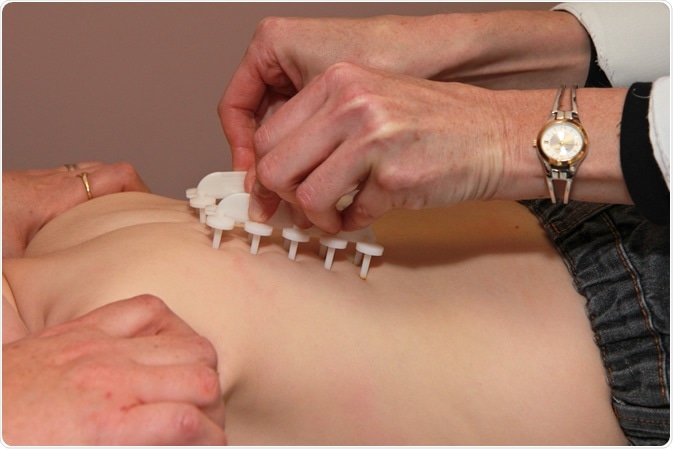Allergies may be suspected in children who develop frequent rashes, or cough or sneeze often, or complain about upset tummies after consuming particular foods. Allergy, or hypersensitivity, is an exaggerated immune response to a substance that would otherwise not elicit an immune reaction.
Pediatric allergies occur when children are hypersensitive to harmless substances in food or the environment. In the United States, allergies are one of the most common medical ailments affecting children. Food, skin and respiratory allergies are among the most frequently reported hypersensitivity reactions.

Pediatric Allergy Skin Test. Image Credit : Anthony Ricci / Shutterstock
Causes
The substance that is responsible for causing an allergy is known as an allergen. Some of the most common allergens are dust mites, pollen, mold spores, food ingredients, insect venom and animal dander. These allergens are eaten, inhaled, or injected. Another route is skin contact during activities performed outdoors, including play. Children are not born with allergies, but do tend to have a genetic predisposition to develop them.
The factors involved in a hypersensitivity reaction are mast cells, immunoglobulin E (IgE) antibodies and, of course, the allergen. When the immune system encounters an allergen for the first time, IgE is produced and these antibodies coat a mast cell’s surface. On subsequent re-exposure to the same allergen, IgE antibodies react with the allergen and this causes mast cells to release histamine and other inflammatory products. It is these released substances that are primarily responsible for the signs and symptoms associated with allergies.
Signs and Symptoms
The clinical presentation of an allergy may vary depending on the location of the body where the hypersensitivity reaction occurs. Furthermore, immune responses may range from mild to severe and life-threatening. Airborne allergens, such as animal dander and pollen, may cause allergies in the eyes, nose and throat as well as further down the respiratory tract in the bronchial passages. The eyes may become itchy, watery, red and swollen, while the nose may be runny and congested with constant sneezing. The throat may feel itchy and a hypersensitive lower respiratory tract may cause wheezing and difficulties breathing.
Food allergies cause swelling and itching of the lips and may lead to a swollen tongue as well, which is a potentially life-threatening scenario. These children may also experience nausea, vomiting, diarrhea, constipation, gastric reflux, or poor feeding. Skin hypersensitivity reactions may manifest as urticaria, eczema and angioedema, which are wheals/hives, cracked/broken/weepy skin, and swelling in the deeper skin layers, respectively. Many of the signs and symptoms of pediatric allergies may resemble other common childhood diseases, but allergies tend to be more dramatic and have a sudden onset.
Diagnosis and Treatment
Diagnosis is made on the grounds of a medical history, physical examination and allergen testing. Allergen tests are performed on the skin by using a minute sample of the suspected allergen. Blood tests can also be taken, but are more expensive than skin tests. Treatment is fairly straightforward and consists of avoiding exposure to the allergen. If it is impossible to completely avoid the substance causing the reaction, then pharmacotherapy may alleviate the symptoms. Long-acting histamines are the drugs of choice, in addition to others that can treat and prevent inflammation. There are also allergy vaccines that may be given over a period of months, which may help strengthen the patient’s tolerance to the substance.
Further Reading
Last Updated: Feb 26, 2019